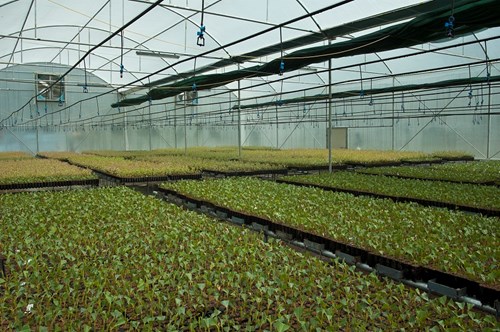Proper Watering Techniques – Part 2


Let's look at some of the different techniques.
Shallow, Low-Volume Watering
Pros: Shallow watering is often used to avoid “flooding” the growing medium to avoid potential root disease. Since less water is applied, the growing medium will dry out sooner, even in the cold, cloudy winter months. This method is better for avoiding root disease early in the plant life cycle. Applying less water reduces saturation of the growing medium, which reduces root stress, and susceptibility to root pathogens and provides greater aeration for plant roots to grow efficiently.
Cons: This method does require more labor to monitor and apply more frequent irrigations. This can lead to uneven drying throughout the crop. Even with the best watering techniques, it can be a struggle to apply the same amount of water to each container. If some plants receive more water than others, it takes longer for them to dry out. Typically, dry plants get the most attention when a growing section is watered, including those plants that have not sufficiently dried out. Over time, dry plants receive proper amounts of water as needed and wet plants become saturated, which leads to uneven drying throughout the crop. If not addressed early, wet plants have slower growth rates, nutritional problems set in, root diseases can develop and the whole crop becomes difficult to manage.
Thorough, Deep Watering
Pros: This type of watering can seem scary especially when growing hanging baskets in February. Baskets can indeed take more than one week to dry out, but as long as there is airflow and no watering until the growing medium dries out, it will not lead to an increased incidence of root disease or growth problems. The main advantage to thorough watering is, that if each container has the same volume of growing medium and plant type(s), then there is equal water retention from one container to the next to reduce the possibility of uneven drying.
Cons: Caution must be taken not to water too frequently. Overwatering does not occur when a plant is given large quantities of water at one time. It occurs over time when water is applied too frequently before the growing medium has a chance to dry out. Overwatering is usually the catalyst that leads to problems ranging from algae and shoreflies to root disease, caused by Pythium and Phytophthora. Reducing the frequency of watering is the proper way to correct overwatering.

Correcting Uneven Drying Problems
As long as crop growth is not severely affected, you can correct uneven drying by adjusting your watering technique. First, water all dry pots or cells, then return an hour or so later to water all plants thoroughly. This is recommended since dry plants may not absorb water readily and a second irrigation is necessary. This type of watering will allow the “dry” growing medium to become partially saturated with the first watering, while the second watering should bring the growing medium back to a saturated state.
On the other end, “supersaturated” wet plants that are watered before they have a chance to dry out can retain up to 40% more water than plants in the same growing medium that have been allowed to properly dry and then watered to saturation. In this case, it may be best to segregate the “supersaturated” plants from the rest of the group so they can be cared for separately to dry out. Once they dry out and are watered, they will not go back to the “supersaturated” condition, unless they are overwatered all over again.
In some cases, re-application of a wetting agent via the irrigation system can benefit the water dynamics of growing medium, particularly long-term crops. As a reminder, frequent air exchanges and adequate airflow are necessary to complement the growing environment. Paying attention to the water needs of crops produces uniform plants, less incidence of diseases, fewer problems with nuisance insects and overall better quality plants.